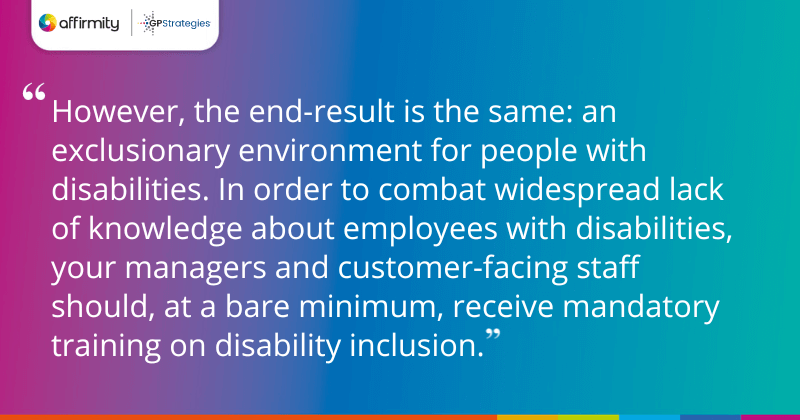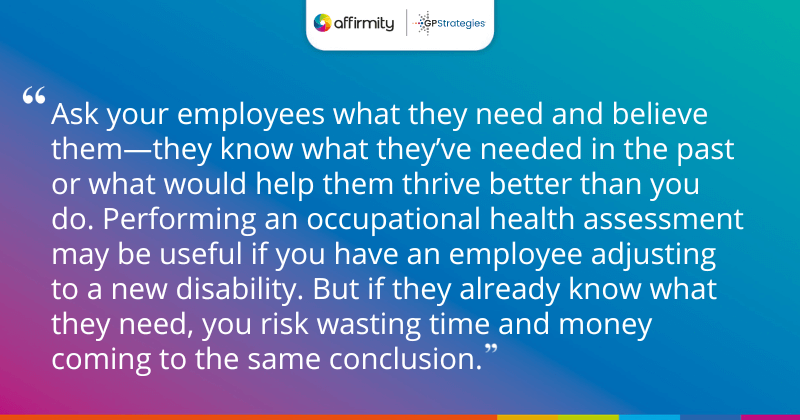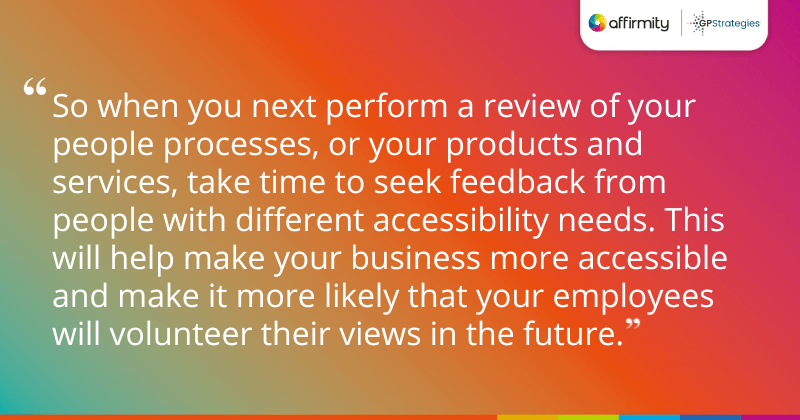The needs of employees with disabilities are too often overlooked, and their input not considered when developing accessible solutions. In this article, diversity and inclusion consultant/trainer, Eleanor Goichman Brett at GP Strategies (an Affirmity inclusion training partner), delves into five inclusive mindsets that will help you better serve your workforce and your customers.
While it goes without saying that we have a duty to create more inclusive and accessible businesses, it’s worth noting that such businesses are almost always more profitable. The UN estimates that there are around 1 billion people living with disabilities worldwide—that’s 15% of the world’s population! Add in their friends and families, and there’s potentially a great deal of spending power dependent on your inclusive practices.
Regardless, it’s important to not lose sight of whether your goals around disability inclusion and accessibility ring true to your current employees, and your potential workforce. Despite being such a significant group globally, people with disabilities are underrepresented in the workplace: overlooked and rarely consulted about how things could be made better for people like themselves.
If your intention is to build a more inclusive business for people with disabilities, here are five ways you can begin to reach that goal.

1) Inclusion Starts With Changes in Attitudes and Behavior
A recurrent theme among surveys of persons with disabilities both in and out of work is that workplace cultures act against their ability to achieve their potential. Colleagues often make negative assumptions about a person’s capabilities, and some experience bullying, harassment, and resentment due to supposed ‘special treatment’.
These attitudes aren’t always a result of negative intent—some colleagues act with a desire to protect others. However, the end-result is the same: an exclusionary environment for people with disabilities. In order to combat widespread lack of knowledge about employees with disabilities, your managers and customer-facing staff should, at a bare minimum, receive mandatory training on disability inclusion. Information about different disabilities should additionally be available on demand.
FURTHER THINKING ON INCLUSION | ‘Are You Pulling the 9 “Levers” of Inclusion?’
2) “Disability” Is a Word That Many Don’t Actually Identify With
Your data on disability is likely not reflective of everyone who could benefit from your work towards disability inclusion. One reason for this is that a number of those who have a disability in legal terms, wouldn’t use the word to describe themselves.
A different approach is needed.
So, instead, ask people about the adjustments and the accessibility measures they need to perform their work. This will help you collect more complete, meaningful, and actionable data.

3) Your People Are Experts on Their Own Accessibility Requirements
You must remain receptive to adaptation or adjustment requests that go beyond your current standards. Ask your employees what they need and believe them—they know what they’ve needed in the past or what would help them thrive better than you do.
Performing an occupational health assessment may be useful if you have an employee adjusting to a new disability. But if they already know what they need, you risk wasting time and money coming to the same conclusion.
RELEVANT READING | ‘5 Key Steps in the Creation, Growth and Evolution of Your ERGs’
4) The Greatest Impairment Is Often Our Social Environments
In many ways, the way the world at large is structured is more of an impairment than any individual condition. A hearing impairment becomes a significant barrier for a person when customer services are only available via phone, for example. Or similarly, dyslexia is a problem only when complex language is used unnecessarily in a policy.
Businesses concerned with creating disability-inclusive environments for both customers and colleagues need to challenge some of these assumptions by talking with those who are potentially affected. Don’t wait for barriers to be discovered by people: make an effort to remove them as standard.
FIND OUT MORE ABOUT ACCESSIBILITY OBLIGATIONS | “4 Key Considerations for Building an Inclusive Work Environment for Individuals with Disabilities”

5) Input Will Make Your Business More Accessible
It’s likely that your organization hasn’t yet accessed a fraction of the internal experience and knowledge that could make it more accessible and inclusive for people with disabilities. Most businesses are in this situation because they’re afraid to ask—and if they get that far, they sometimes aren’t prepared to listen and act on the unflattering feedback they receive.
So when you next perform a review of your people processes, or your products and services, take time to seek feedback from people with different accessibility needs. This will help make your business more accessible and make it more likely that your employees will volunteer their views in the future.
Are you ready to begin building internal and external trust among potential and employees with disabilities? Contact us to learn more about disability inclusion and other ideas for a more accessible workplace.
 About the Author
About the Author
Eleanor Goichman Brett is a Global Inclusion Consultant at GP Strategies. Having completed a dissertation in the unconscious bias of attractiveness, she has also worked at Virgin Media, the Alzheimer’s Society and Ciklum Software to implement internal diversity and inclusion and accessibility strategies. With a motto of ‘data, action, data’, Eleanor helps organizations not only design and implement inclusion and learning plans that are right for them but also ensure measurement and sustainability.
